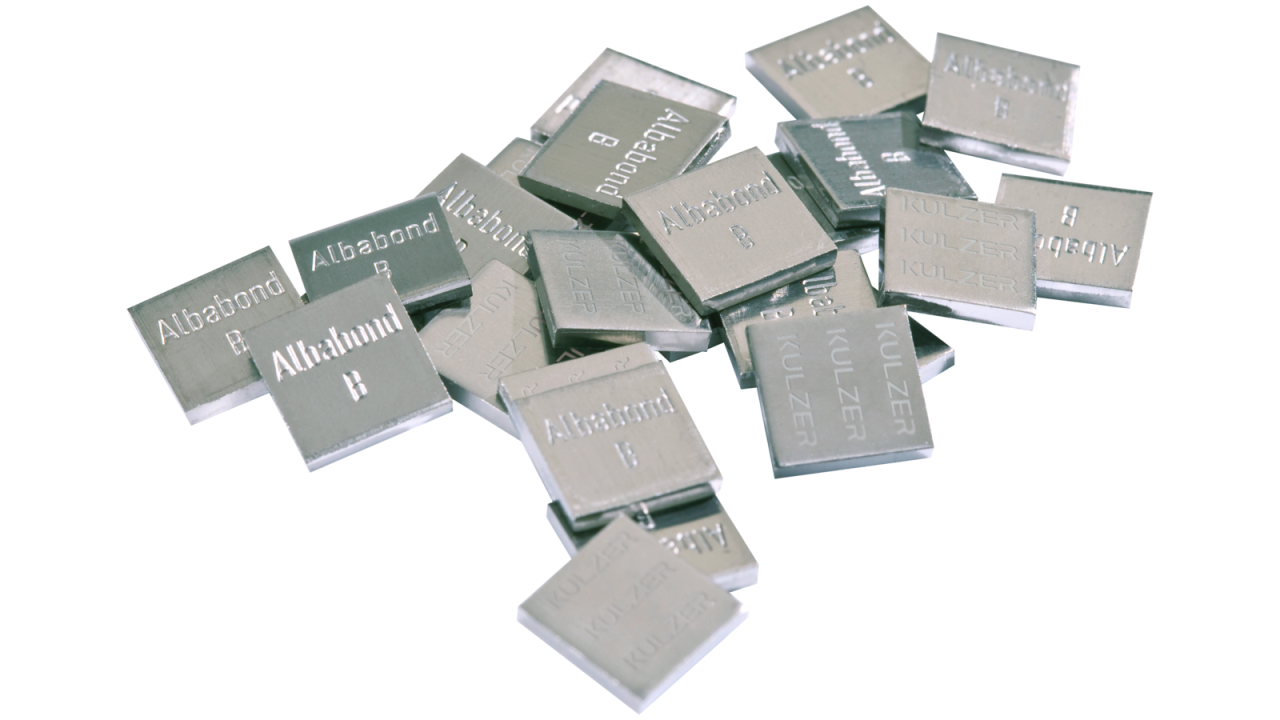Contact Kulzer International

Albabond® B - for C& B
Pd-based ceramic bonding alloy acc. to EN ISO 9693-1 and 22674, white
Benefits
- Ideal for all indications of ceramic veneering
- Copper free
- Can be used for most ceramic materials
- Exceptional polishability
- Universal veneering capability with ceramics or composites
Indications
- Crowns
- Bridges
- Milling procedures
- Implants
Specifications
| Product details | ||||||||||||||
|---|---|---|---|---|---|---|---|---|---|---|---|---|---|---|
|
Composition (Content in mass %) |
Pd 74.4 Au 5.3 Ag 6.5 Sn 8.0 In 1.0 Ga 4.5 Ru 0.3 |
|||||||||||||
| Type (Classification acc. EN ISO 22674) |
4 (s/v/k) s= self-hardening alloy after slow cooling in the mould v= Condition after hardening k= Bonding alloy: condition after ceramik firing |
|||||||||||||
| Shade | White | |||||||||||||
| Indication |
Crowns Bridges Milling technique Implant restorations |
|||||||||||||
|
Article Code |
1095 0000 | |||||||||||||
| Technical data, melting and casting | ||||||||||||||
|---|---|---|---|---|---|---|---|---|---|---|---|---|---|---|
| Melting range(1) |
Solidus 1120 °C Liquidus 1300 °C |
|||||||||||||
| Preheating Temperature | 900 °C | |||||||||||||
| Casting Temperature | 1450 °C | |||||||||||||
| Crucible | Ceramic | |||||||||||||
| Density(1) | 11.7 g/cm³ | |||||||||||||
| Hardness, HV5 |
w/k 225 v 240 s 225 |
|||||||||||||
| 0.2% proof stress(1), MPa(2) |
w/k 460 v 470 |
|||||||||||||
| Elongation(1) % |
w/k 41 v 40 |
|||||||||||||
| Elastic modulus (1), GPa(2) | 128 | |||||||||||||
| Solder/Laser welding wire | ||||||||||||||
|---|---|---|---|---|---|---|---|---|---|---|---|---|---|---|
| Prior to Ceramic Firing | ||||||||||||||
| Solder | Herador Lot | |||||||||||||
|
Herador 1070 Lot Working temperature °C: 1070 / Solder colour: white |
||||||||||||||
|
Herador 1060 Lot Working temperature °C: 1060 / Solder colour: yellow |
||||||||||||||
|
Herador 1060 S Lot Working temperature °C: 1060 / Solder colour: yellow |
||||||||||||||
| After Ceramic Firing | ||||||||||||||
| Solder | Herador Lot V(1) | |||||||||||||
| Flux** | Work. temp.* 800°C / Solder colour: light yellow | |||||||||||||
| Alloy also available as Laser welding wire | ||||||||||||||
| Ø 0.5 mm x 200 mm | + | |||||||||||||
| Ø 0.3 mm x 200 mm | + | |||||||||||||
Specification legend
Explanation of abbreviations and numbering:
x = content < 0.1 mass%
Indications:
1 Inlays, cervical filling
2 MOD Inlays
3 Crowns
4 Bridges
5 Milling technique
6 Partial dentures
10 Cast posts
14 Can be veneered with high expansion, low-fusing ceramics
15 Implant restorations
16 Electroformed double crown technique (primary crowns)
Abbreviations:
w = after soft annealing and quenching
k = ceramic bonding alloy: condition after ceramic firing
v = after hardening
s = self-hardening after slow cooling in the mould
A = A stable framework design with reinforced connections with a cross section of 8 - 10 mm² is required for long span bridges and superstructures. Additionally, the frameworks need to be hardened.
B = Depending on the copper content, in some cases discolouration ofdouble crowns may result after short period of wearing. Discolouration, however, is technically and physiologically harmless.
C = In exceptional cases these alloys can also be used for traditional telescopic crowns with parallel walls and for the bar casting technique provided that cross-sections for crown walls, approximal areas, bars and laser welded joints are particularly thick and the alloy is hardened subsequently. No indication for conical crowns and sheardistributors.
Please observe instructions for use included during delivery when processing of the alloy!

